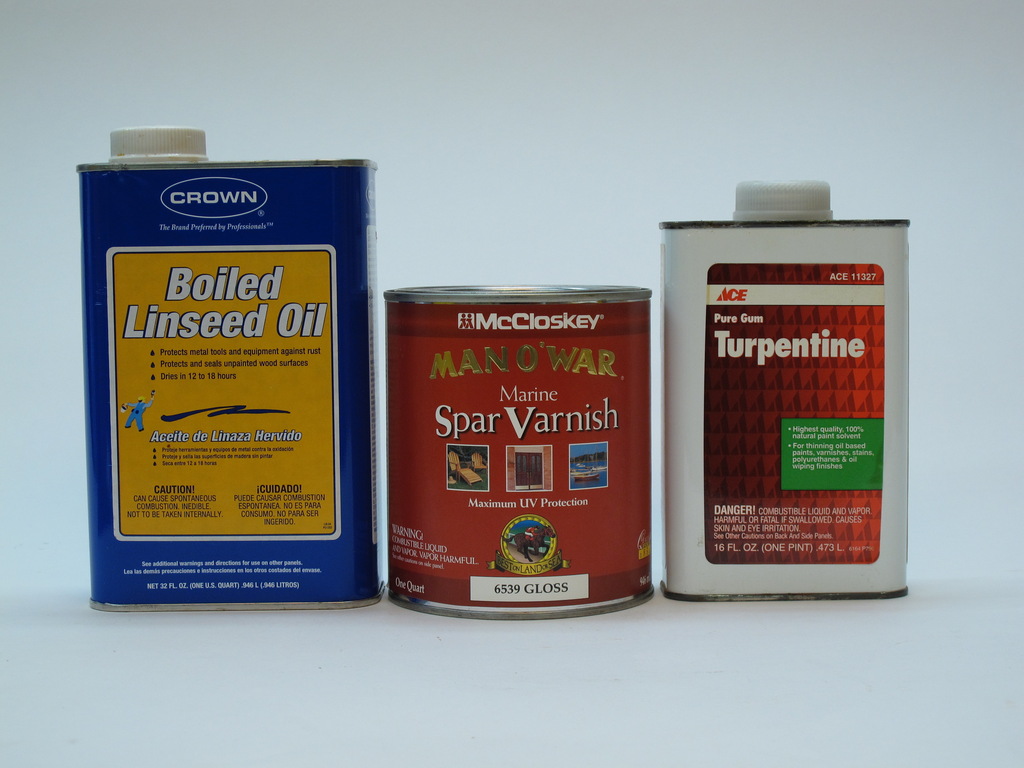We may receive a commission when you use our affiliate links. However, this does not impact our recommendations.

These are the three products suggested in the 1976 article for making an oil/varnish blend.
A former student of mine from 10 years ago emailed me with a question about what he remembered was a formula I had come up with for a wipe-on finish. He had looked in his notes but couldn’t find anything.
I think he was referring to tests I had done to tweak oil/varnish blends like Watco Danish Oil, because I had never come up with my own formula. I have stuck pretty consistently to Watco when I wanted to use this type of finish.
For the tests, I compared higher ratios of varnish-to-oil with higher ratios of oil-to-varnish. And what I came up with was pretty much what you would expect. Higher percentages of varnish yielded slightly more gloss and higher percentages of linseed oil yielded a lower gloss. But the differences weren’t very much, so I never switched to one of these formulas over Watco.
To go into a little more explanation, the purpose of the varnish in the mix is to give the finish a little more durability – that is, resistance to scratches and moisture penetration. The purpose of the oil in the mix is to make the finish easier to apply by providing more time before setting up.
Watco was introduced into the woodworking community way back in the mid-1970s (Spring of 1976) in the second issue of Fine Woodworking magazine. At that time this finish was not widely available, so the author of the article told us how to make it. His formula was one part boiled linseed oil, two parts gloss varnish and three parts turpentine.
I just went back and reread the article to refresh my memory and found several interesting points. Keep in mind that woodworkers’ knowledge of finishes was pretty primitive back then compared to now, so I don’t mean any of this to be critical. Just interesting in retrospect.
We’re supposed to use pure, boiled linseed oil with no driers or other additives. Of course, boiled linseed oil is distinguished from raw linseed oil by the addition of driers. Raw linseed oil with no driers takes weeks or longer to dry. The misunderstanding here is probably due to the use of the word “boiled,” which is, or was, widely interpreted to mean actually boiled!
Also interesting was the instruction to use turpentine. The article specifically states, “do not use mineral spirits or other substitutes.” There’s no reason I can think of to not use mineral spirits. But I remember that there used to be more confusion about this. Turpentine was often thought to be better, even though it evaporates just as mineral spirits does, so it has no impact on the resulting dried finish.
The author does give good instructions for application, though, in contrast to the Watco brand itself. We are told to apply one coat a day for three days, wiping off the excess each time after letting the finish sit wet for a little while. Watco instructed (and still instructs, which I find incredible) to apply a second and final coat 45 minutes after wiping off the first coat. Because of the length of time it takes for this finish to dry, this second coat adds nothing. It just mixes with the first, so you are really applying just one coat. And this doesn’t yield good results.
Here are some supplies and tools we find essential in our everyday work around the shop. We may receive a commission from sales referred by our links; however, we have carefully selected these products for their usefulness and quality.









I have used a recipe called “Hotrod your Varnish” from an article in Fine woodworking. It uses varnish, tung oil, turpentine and japan dryer. I skip the turpentine… the work will smell months later. I apply three coats sanding the finish in with 400 grit paper on the first coat. I find it leaves it leaves a nice finish on top of the wood where watco just does build up.